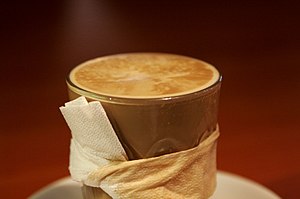Latte
Latte is Italian for milk. In English-speaking countries it usually refers to one of several types of coffee beverages made with hot milk. In Italian these are known as "caffè e latte" (commonly "caffellatte"), literally "coffee and milk", analogous to (but not the same as) the French "café au lait", and latte macchiato which is very similar.
As the term has come to be used in much of the world outside Italy since the early 1980s, a latte is prepared to the proportions of one third espresso and two-thirds steamed milk. Thus it has more milk than a cappuccino, and has a milder, milkier taste. Lattes should be prepared by pouring milk and coffee simultaneously, from either side of the drinking vessel.
The evolution of this term (and this particular form of the beverage) is relatively recent and probably dates from the spread of the 1980s Seattle coffee craze to the rest of the United States (and beyond) via the growth of Seattle-based Starbucks. Some cafes create designs in the frothed milk.
As recently as 1980, if you ordered a "latte" in an Italian coffeehouse in North America, you would expect to get a glass of milk. If you ordered a "caffè latte," you would get a beverage with far less milk in it than what has now come to be called a "latte."
Keep in mind, ordering a "latte" in a café in Italy will result in the barista serving you a plain glass of milk.
In some establishments, lattes are served in a glass on a saucer with a napkin which can be used to hold the (sometimes hot) glass. Some baristas will heat the milk to only 65–70 °C, above which temperature the milk changes in flavour. These beverages are typically made using a 30 ml shot of espresso coffee and topped up with frothed or textured milk. In other establishments, the latte may even be served in a bowl.
Milk in a latte is often served "frothed", sometimes decoratively.
External links
- Latte World - Website for latte news
